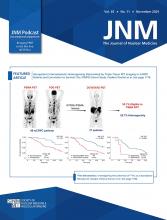Visual Abstract
Abstract
This single-center, single-arm, phase II trial (ChiCTR2100050057) investigated the ability of 18F-labeled fibroblast activation protein inhibitor ([18F]AlF-NOTA-FAPI-04, denoted as 18F-FAPI) PET/CT to predict the response to neoadjuvant camrelizumab plus chemotherapy (nCC) in locally advanced esophageal squamous cell carcinoma (LA-ESCC). Methods: This study included 32 newly diagnosed LA-ESCC participants who underwent 18F-FAPI PET/CT at baseline, of whom 23 also underwent scanning after 2 cycles of nCC. The participants underwent surgery after 2 cycles of nCC. Recorded PET parameters included maximum, peak, and mean SUVs and tumor-to-background ratios (TBRs), metabolic tumor volume, and total lesion FAP expression. PET parameters were compared between patient groups with good and poor pathologic responses, and the predictive performance for treatment response was analyzed. Results: The good and poor response groups each included 16 participants (16/32, 50.0%). On 18F-FAPI PET/CT, the posttreatment SUVs were significantly lower in good responders than in poor responders, whereas the changes in SUVs with treatment were significantly higher (all P < 0.05). SUVmax (area under the curve [AUC], 0.87; P = 0.0026), SUVpeak (AUC, 0.89; P = 0.0017), SUVmean (AUC, 0.88; P = 0.0021), TBRmax (AUC, 0.86; P = 0.0031), and TBRmean (AUC, 0.88; P = 0.0021) after nCC were significant predictors of pathologic response to nCC, with sensitivities of 63.64%–81.82% and specificities of 83.33%–100%. Changes in SUVmax (AUC, 0.81; P = 0.0116), SUVpeak (AUC, 0.82; P = 0.0097), SUVmean (AUC, 0.81; P = 0.0116), and TBRmean (AUC, 0.74; P = 0.0489) also were significant predictors of the pathologic response to nCC, with sensitivities and specificities in similar ranges. Conclusion: 18F-FAPI PET/CT parameters after treatment and their changes from baseline can predict the pathologic response to nCC in LA-ESCC participants.
Footnotes
Published online Sep. 26, 2024.
- © 2024 by the Society of Nuclear Medicine and Molecular Imaging.
This article requires a subscription to view the full text. If you have a subscription you may use the login form below to view the article. Access to this article can also be purchased.
SNMMI members
Login to the site using your SNMMI member credentials
Individuals
Login as an individual user








